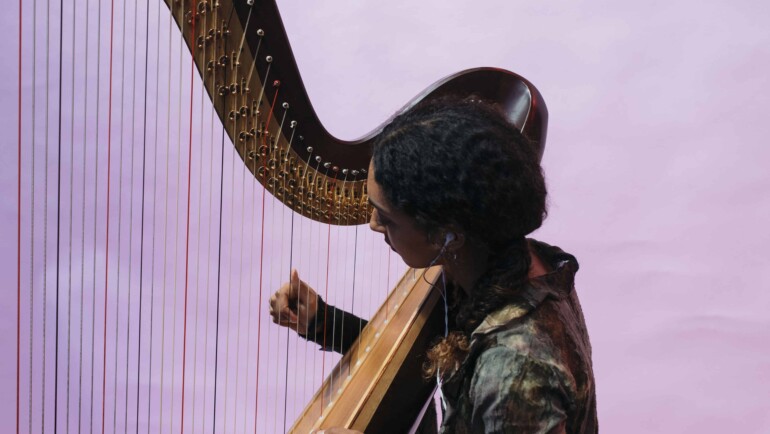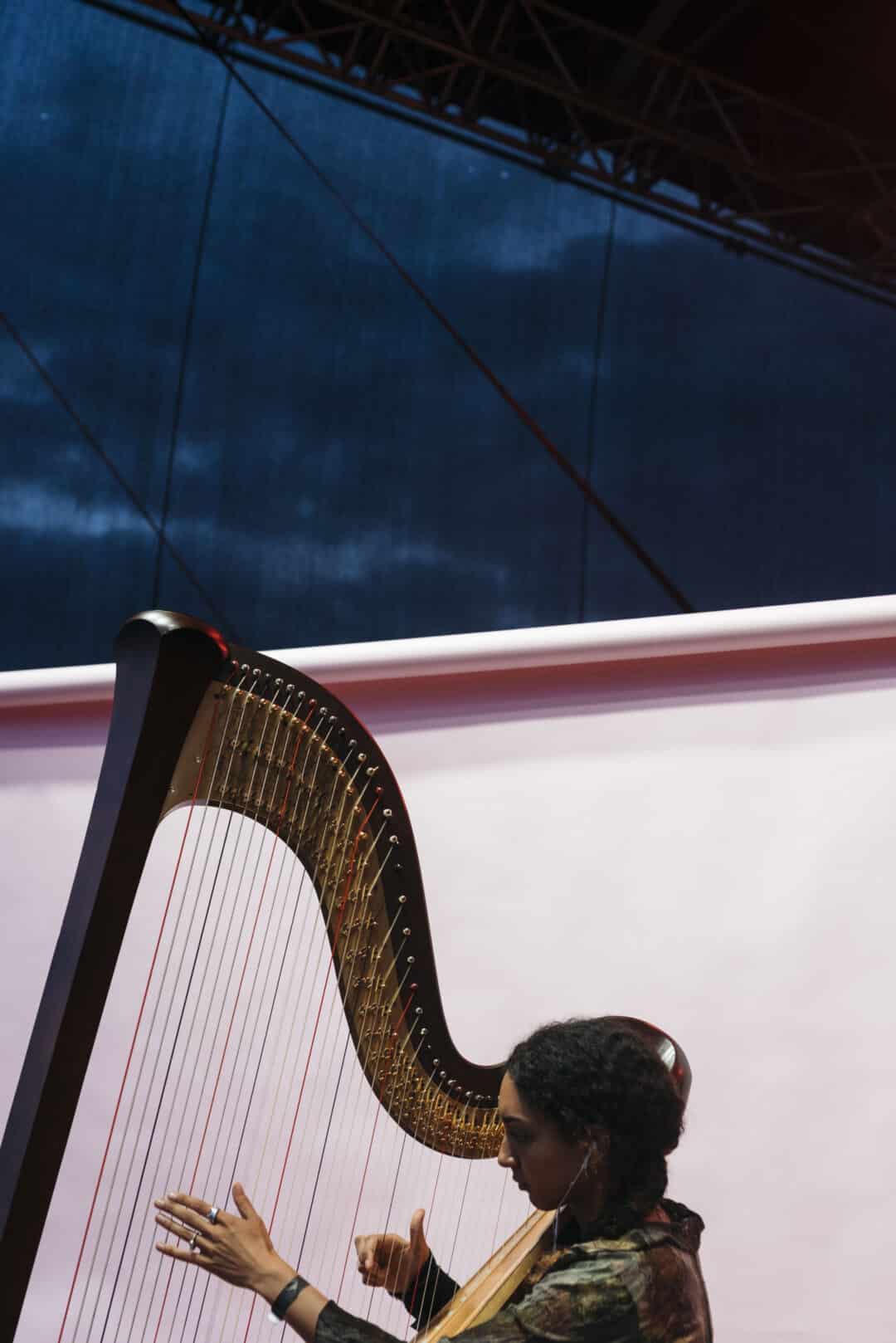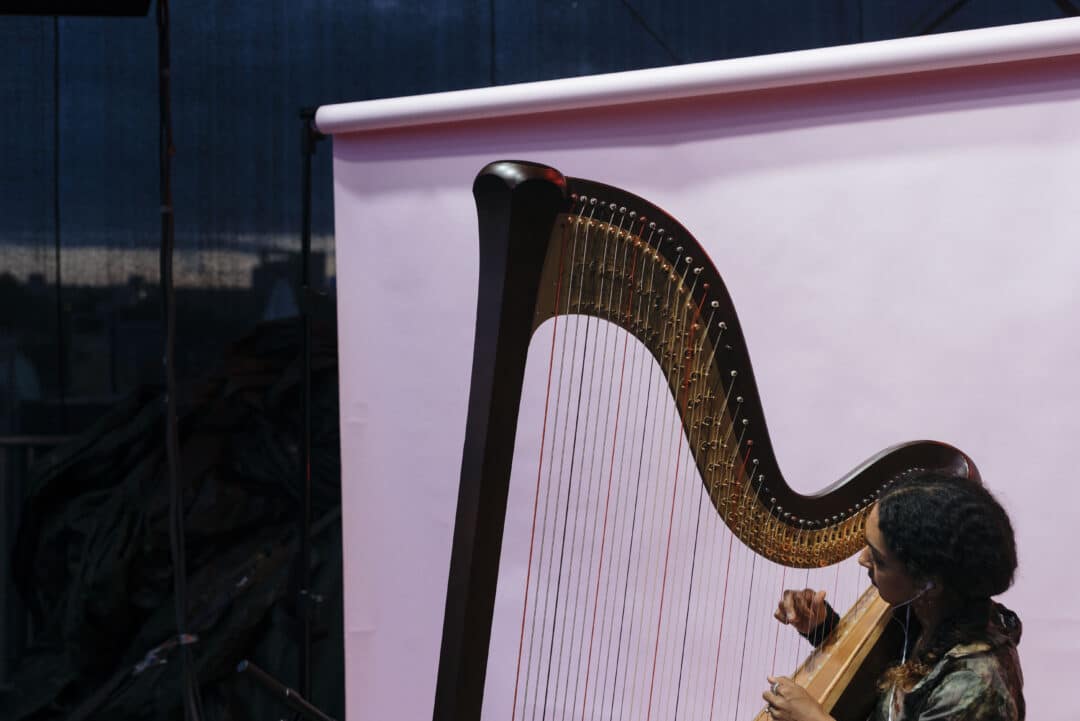
“Naturally, anything where you don’t know the outcome is scary. Letting go of that fear is part of that process.”
Once upon a time in a small Austrian village called Perchtoldsdorf, there lived a little girl who had dreams of being a princess. One evening, on a visit to the village hall, she set her eyes upon the most celestial human she had ever seen. In the hands of this magical person lay a golden instrument which enchanted the young girl and drew her closer and closer until she found herself touching it. That special instrument would guide the rest of her journey to become what was now clear she really wanted to be, and, the closest to her princess-inspired visions: a harpist.
Fairy tales are just fairy tales right? Well, the above is a true story and to this day Miriam Adefris’ musical career is nothing short of a dream come true for most musicians.
In fact, she dials into the interview via zoom from the Cayman Islands where she was contacted by an agency organising creative residencies at an exclusive boutique hotel there. Phew. It was not quite real for even Miriam who was still pinching herself from the opportunity, although her talent and hard work make it very unsurprising to anyone else that she already has such accolades under her belt.
Born and raised in a small town just outside of Vienna, Austria, Miriam has since in her adult career entered the European music scene with gusto performing in both Austrian festivals and in Germany (Xjazz! Festival Berlin), Italy and the UK (London Jazz Festival) as well as collaborating with, to name a one epic example, electronic musician Floating Points. In her youth, Miriam was trained, like many with the harp, in classical music – known for its formal, rigorous training and heavily eurocentric in its repertoire, not least in European schools of training and education. In this field perfection is fundamental and is solidified by learning, rehearsing and replaying pieces performed in recitals and concerts – from smaller stages to big orchestral constellations. These early years and environments naturally formed a lot of Miriam’s initial ideas in music and of the harp.
“I just kept coming back to it.”
Alongside that though, Miriam was very engaged, and at a competitive level, in sports – from acrobatics to horse riding. Like her early experiences with the harp, there, she also gained discipline but this also increasingly developed at the same time ideas of teamwork as well as training different parts of her body and mind to adapt. To this end, both flexibility and rigour would characterise a lot of her later career decisions in music, too. She says: “It was always all or nothing with everything I tried out. I was always competitive, but that drive was always channeled inwards, towards myself”.
The main motivation for Miriam’s work is, however, neither from competition, discipline nor conviction, but rather from a place of love. She calls the harp the love of her life and often refers to it almost like a partnership. And quite true to that, she has fallen in and out of love with it too: “at the age of 11 it wasn’t cool anymore to play the harp, so I focused on sports”, she laughs. “There were two times, actually, then and later in my career, where I tried to walk away from the harp, but it just wouldn’t let me. I just kept coming back to it.” This synergy between the artist and her instrument is so beautifully reflected in their joint development. As she has expanded her skills and experience she tells me so does a harp also develop. She explains to me that the wood of the instrument develops the more as it is being played which improves the sound with time.

And this development was crucial, too, from her background in classical music: growth was a catalyst for her decision to move to the UK, with her harp, for a change of scene and inspiration. There Miriam enrolled in a Masters in Performance program at the University of Goldsmith in 2020 and in the midst of the pandemic, and during the arduous rolling out of Brexit, it meant she had to make a decision to stay in the UK. That serendipity, if you will, meant that embarking on an educational path again was one of the only viable options for her to remain in the UK. Miriam used this time to network and made some of the most important connections that would kick-start not only a more international career but also her move away from classical music into other genres and art forms. And these interactions and inspirations – having even been tutored in London at one point by jazz harpist Alina Bzhezhinska – set ablaze an intrigue in her which had already been sparked in Vienna.
“Everything I do has some elements of improvisation in it.”
After graduating from the Music and Arts University Vienna (MUK), and playing in for several orchestras thereafter, Miriam founded an ensemble which explored improvisational styles. This formed a basis upon which she was keen to build upon 3 years later in her degree and in her connections in the cosmopolitan, more progressive and experimental city of London. “I wanted to go from being a musician reproducing (classical) music to someone producing music myself”, she says. “I often float between genres now; even though I am still a very much analogue harpist, it is more about having a creative output”. By educating herself on jazz theory foregrounding jazz-related exercises, as well as reading music from reed instruments, Miriam has delved into experimentation by learning from other instruments, too. “Everything I do has some elements of improvisation in it.” This jump from her very locally-informed knowledge and understanding – in Austria the harp is very central to Volksmusik (folk music) – to a broader, albeit, decolonial approach, meant Miriam began to explore alternative sources of harp playing and theory. Moving beyond those early associations, Miriam discovered the limitations of her instrument of choice, too. It is no small task to adapt harp playing to a variety of techniques and genres she reveals: “as the harp is tuned diatonically and has seven pedals in order to play semitones. This means it is sometimes a bit slower in playing more complex harmonic changes”. But Miriam does not see this as a disadvantage, in fact she takes it as an impulse: “I have to be more creative and find solutions which often turn out to be more exciting than the initial task”.
In fact, she seems to be using the harp and staying true to its roots at the same time as pushing boundaries for it. Unlike its classical and Eurocentric association, the harp can be traced back to Iraq, Egypt and Iran before making its way to Europe in the Middle Ages. Despite this, jazz tradition in harp is much less institutionalised than other genres, so by intentionally practising and playing with other instruments more versed with jazz theory and performance, Miriam pushes the boundaries of harp by learning and testing and each time it is therefore also new territory for herself and her craft. No surprise then that her two idols did the same – two of her greatest influences are pioneers in the field: Alice Coltrane and Dorothy Ashby, who both completely reshaped the image of the instrument and invented a whole new way of playing. For Miriam both are still fascinating individuals. “Then, they were two of the very few female, and additionally Black, instrumentalists. I worship them like goddesses and their musical legacy is absolutely invaluable”.
“There is so much magic in that moment.”
Equally referencing the great influences in her musical career, Miriam’s east African heritage also plays a part in her music: “Ethiopian jazz and harp from the 60s and 70s has had an impact on my work for sure”. Miriam, in a moment of reflection, compares her current journey to her classical past where, she says, back then, the mere thought of improvisation felt so distant and was daunting. “You are trained to perfection and so scared of making mistakes […]. Letting go of that fear is part of that process but it is also the most satisfying; it gives so much freedom”.
Communication with musicians instead of solely playing alongside them got her hooked, in her own words, and she began to start exploring that: “Sometimes I listen back to improvs (improvisations) and I am so blown away about the process and what can happen in the moment. You could never come up with that alone. There is so much magic in that moment.” And from such moments she has had so many more brilliant opportunities to perform with some greats, from ongoing collaborations with Floating Points to Valentina Magaletti (“an important experimental drummer”, she excitedly tells me). Just this March she played alongside Shabaka Hutchings at the Shakespeare Globe Theatre in London. Miriam has also recently formed her own 4-piece-band with their very first public performances having taken place at London jazz club 606 and London Jazz Festival IN 2022. This October in Vienna, Miriam will lead concerts for school classes at both Musikverein and the Wiener Konzerthaus. She is currently working on a solo album that she plans to release at the end of this year. Stay very much tuned.
Even with all these explorations and experimentation and being so far from home, Miriam Adefris is still connected to the humble beginnings of her journey with her instrument – it is still the harp that she holds onto and the one that is making all of her childhood dreams come true.
This is a tale of a woman and her harp.

